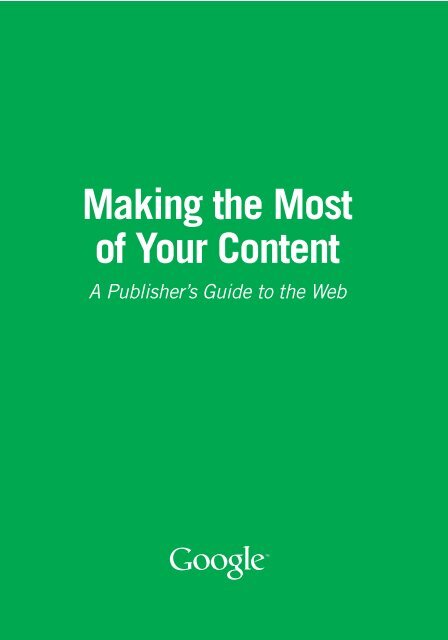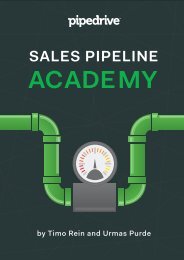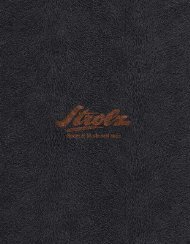Making the Most of Your Content - A Publisher's Guide to the Web
At Google we’re frequently asked how web search works, and how web publishers can maximise their visibility on the Internet. We’ve written this short booklet to help you understand how a search engine ‘sees’ your content, and how you can best tailor your
At Google we’re frequently asked how web search works, and how web publishers can maximise their visibility on the Internet. We’ve written this short booklet to help you understand how a search engine ‘sees’ your content, and how you can best tailor your
Create successful ePaper yourself
Turn your PDF publications into a flip-book with our unique Google optimized e-Paper software.
<strong>Making</strong> <strong>the</strong> <strong>Most</strong><br />
<strong>of</strong> <strong>Your</strong> <strong>Content</strong><br />
A Publisher’s <strong>Guide</strong> <strong>to</strong> <strong>the</strong> <strong>Web</strong>
<strong>Content</strong>s<br />
Introduction 2<br />
A brief overview <strong>of</strong> web search 3<br />
What’s new in Google web search? 4<br />
Can Google fi nd your site? 5<br />
Can Google index your site? 6<br />
Controlling what Google indexes 7<br />
Robots.txt vs. meta tags 9<br />
Controlling caching and snippets 10<br />
Does your site have unique and useful content? 11<br />
Increasing visibility: best practices 12<br />
<strong>Web</strong>master Central 13<br />
Sitemaps 14<br />
Frequently Asked Questions 15<br />
Glossary 19
Introduction<br />
If you’re looking for visibility, <strong>the</strong> Internet is <strong>the</strong> place <strong>to</strong> be.<br />
Just ask any advertiser who has increased sales using online<br />
ads, a blogger whose popularity has led <strong>to</strong> a book deal, or a<br />
newspaper that has expanded its readership <strong>to</strong> an international<br />
audience thanks <strong>to</strong> increased traffi c.<br />
At Google we’re frequently asked how web search works, and<br />
how web publishers can maximise <strong>the</strong>ir visibility on <strong>the</strong> Internet.<br />
We’ve written this short booklet <strong>to</strong> help you understand how a<br />
search engine ‘sees’ your content, and how you can best tailor<br />
your web presence <strong>to</strong> ensure that what you want <strong>to</strong> be found is<br />
found – and what you want <strong>to</strong> keep hidden, stays hidden.<br />
From webmaster tips and online <strong>to</strong>ols, <strong>to</strong> a step-by-step guide <strong>to</strong><br />
frequently asked questions, this booklet is geared <strong>to</strong>wards small<br />
web publishers as well as owners <strong>of</strong> large sites.<br />
Just as <strong>the</strong> Internet itself has evolved dramatically in <strong>the</strong> past<br />
decade, so has Google’s own approach <strong>to</strong> web search and its<br />
relationship with site owners. We’ve created numerous <strong>to</strong>ols <strong>to</strong><br />
help webmasters maximise <strong>the</strong> visibility <strong>of</strong> <strong>the</strong>ir content, as well<br />
as control how <strong>the</strong>ir web pages are indexed. But <strong>the</strong>re’s always<br />
more we can do. We hope that this booklet will encourage you <strong>to</strong><br />
give us feedback and let us know what we can do <strong>to</strong> make <strong>the</strong><br />
web an even better place for both searchers and publishers.<br />
- The Google <strong>Web</strong>master Team<br />
A brief overview <strong>of</strong> web search: How it works<br />
In <strong>the</strong> most simple <strong>of</strong> terms, you could think <strong>of</strong> <strong>the</strong> web as a very large book, with an<br />
impressive index telling you exactly where everything is located.<br />
Google has a set <strong>of</strong> computers – <strong>the</strong> ‘Googlebot’ – that are continually ‘crawling’<br />
(browsing) billions <strong>of</strong> pages on <strong>the</strong> web. This crawl process is algorithmic: computer<br />
programs determine which sites <strong>to</strong> crawl, how <strong>of</strong>ten, and how many pages <strong>to</strong> fetch<br />
from each site. We don’t accept payment <strong>to</strong> crawl a site more frequently, and we keep<br />
<strong>the</strong> search side <strong>of</strong> our business separate from our revenue-generating AdWords service.<br />
Google’s crawl process begins with a list <strong>of</strong> web page URLs. As <strong>the</strong> Googlebot<br />
browses <strong>the</strong>se websites it detects links on each page and adds <strong>the</strong>m <strong>to</strong> its list<br />
<strong>of</strong> pages <strong>to</strong> crawl. The Googlebot makes a copy <strong>of</strong> each <strong>of</strong> <strong>the</strong> pages it crawls in<br />
order <strong>to</strong> compile a massive index <strong>of</strong> all <strong>the</strong> words it sees. That list also indicates<br />
where each word occurs on each page.<br />
When a user enters a query, our machines search <strong>the</strong> index for matching pages and<br />
return <strong>the</strong> most relevant results <strong>to</strong> <strong>the</strong> user. Relevancy is determined by over 200<br />
fac<strong>to</strong>rs, one <strong>of</strong> which is <strong>the</strong> ‘PageRank’ for a given page. PageRank is <strong>the</strong> measure <strong>of</strong><br />
<strong>the</strong> ‘importance’ <strong>of</strong> a page based on <strong>the</strong> incoming links from o<strong>the</strong>r pages. In simple<br />
terms, each web page linking <strong>to</strong> <strong>Web</strong> page XYZ adds <strong>to</strong> <strong>Web</strong> page XYZ’s PageRank.<br />
During <strong>the</strong> search<br />
Before <strong>the</strong> search<br />
3
What’s new in Google web search?<br />
While <strong>the</strong> fundamentals <strong>of</strong> web search have largely remained constant, Google is<br />
constantly working <strong>to</strong> improve its search results.<br />
What’s different from web search, say, fi ve years ago? Well, for one it’s a lot faster.<br />
In addition, compared <strong>to</strong> fi ve years ago our crawl and index systems are much<br />
more intelligent. For example, we now browse web pages continuously, and<br />
schedule visits <strong>to</strong> each page in a smarter way so as <strong>to</strong> maximise freshness.<br />
This more effi cient approach takes in<strong>to</strong> account <strong>the</strong> fact that a newspaper’s<br />
online site, for example, needs frequent crawling whereas a static website<br />
updated once a month does not. In fact, we are also letting webmasters control<br />
how frequently we crawl <strong>the</strong>ir sites through our webmaster <strong>to</strong>ols. Overall this<br />
results in a fresher and more comprehensive index.<br />
Although web search <strong>to</strong>day is faster and more effi cient than ever, <strong>the</strong> key fac<strong>to</strong>rs<br />
determining a website’s visibility in <strong>the</strong> Google search results have been a priority<br />
since <strong>the</strong> day our search engine made its debut:<br />
Can Google fi nd <strong>the</strong> site? (page 5)<br />
Can Google index <strong>the</strong> site? (page 6)<br />
Does <strong>the</strong> site have unique and useful content? (page 11)<br />
Can Google fi nd your site?<br />
4 5<br />
Inclusion in Google’s search results is free and easy; you don’t even need <strong>to</strong> submit<br />
your site <strong>to</strong> Google. In fact, <strong>the</strong> vast majority <strong>of</strong> sites listed in our results aren’t<br />
manually submitted for inclusion, but found and added au<strong>to</strong>matically when <strong>the</strong><br />
Googlebot crawls <strong>the</strong> web.<br />
Although Google crawls billions <strong>of</strong> pages, it’s inevitable that some sites will be missed.<br />
When <strong>the</strong> Googlebot misses a site, it’s frequently for one <strong>of</strong> <strong>the</strong> following reasons:<br />
<strong>the</strong> site isn’t well connected through multiple links<br />
<strong>to</strong> o<strong>the</strong>r sites on <strong>the</strong> web;<br />
<strong>the</strong> site launched after Google’s most recent crawl was completed;<br />
<strong>the</strong> site was temporarily unavailable when we tried <strong>to</strong> crawl it or we received<br />
an error when we tried <strong>to</strong> crawl it.<br />
Using Google webmaster <strong>to</strong>ols such as Sitemaps, you can determine whe<strong>the</strong>r your<br />
site is currently included in Google’s index and whe<strong>the</strong>r we received errors when<br />
we tried <strong>to</strong> crawl it increased (see page 14). You can also use <strong>the</strong>se <strong>to</strong>ols <strong>to</strong> add<br />
your URL <strong>to</strong> Google’s index manually, or provide Google with a Sitemap that gives<br />
us greater insight in<strong>to</strong> your content. This helps us fi nd new sections and content<br />
from your site.
Can Google index your site?<br />
Occasionally, webmasters will discover that <strong>the</strong>ir sites are not appearing in search<br />
results. The issue could be one <strong>of</strong> ‘indexability’ – whe<strong>the</strong>r or not <strong>the</strong> Googlebot<br />
can make a copy <strong>of</strong> a web page for inclusion in our search results.<br />
Structure and <strong>Content</strong><br />
A common reason for non-inclusion in search results is tied <strong>to</strong> <strong>the</strong> structure and<br />
content <strong>of</strong> <strong>the</strong> web page. For example, a page that requires a user <strong>to</strong> fi ll out a<br />
form may not be indexable by Google. Nor can a page using ‘dynamic content’<br />
(Flash, JavaScript, frames or dynamically generated URLs) always be easily<br />
indexed by search engines. If you are wondering whe<strong>the</strong>r this might be your<br />
site’s problem, try viewing <strong>the</strong> site in a text browser like Lynx or in a browser with<br />
images, Javascript, and Flash turned <strong>of</strong>f, which will signal whe<strong>the</strong>r all <strong>of</strong> your<br />
content is accessible.<br />
If your site uses a lot <strong>of</strong> images, ensure that you describe <strong>the</strong> important content<br />
<strong>of</strong> each image in <strong>the</strong> text. Not only does this allow search engines <strong>to</strong> index <strong>the</strong><br />
image correctly, it also makes <strong>the</strong> image accessible <strong>to</strong> visually impaired users.<br />
You can also make use <strong>of</strong> alt text for <strong>the</strong> image and use descriptive fi lenames, as<br />
shown in this example (which is an image <strong>of</strong> a logo for a company called ‘Buffy’s<br />
House <strong>of</strong> Pies’):<br />
<br />
URLs<br />
An additional hurdle could be <strong>the</strong> URL itself. If <strong>the</strong>re are session IDs or several<br />
parameters in <strong>the</strong> URL, or if <strong>the</strong> URL redirects a number <strong>of</strong> times, Google may not<br />
be able <strong>to</strong> index <strong>the</strong> page.<br />
Server and Network<br />
Server or network issues may prevent us from accessing certain pages <strong>of</strong> your site.<br />
By using <strong>to</strong>ols available at Google’s <strong>Web</strong>master Central, publishers can see a<br />
list <strong>of</strong> <strong>the</strong>ir pages <strong>the</strong> Googlebot cannot access. To learn more about <strong>Web</strong>master<br />
Central, see page 13.<br />
Robots Exclusion Pro<strong>to</strong>col<br />
Occasionally pages will be blocked by <strong>the</strong> Robots Exclusion Pro<strong>to</strong>col, a technical<br />
standard that allows web publishers <strong>to</strong> ‘tell’ search engines not <strong>to</strong> index <strong>the</strong>ir<br />
site’s content (see page 7). If your website isn’t appearing in Google search<br />
results you should check <strong>to</strong> ensure that robots.txt or a meta tag isn’t blocking<br />
access <strong>to</strong> our crawlers.<br />
Controlling what Google indexes<br />
6 7<br />
Every web publisher has a different goal for what he or she is trying <strong>to</strong> achieve on<br />
<strong>the</strong> Internet. Some newspaper publishers, for example, have chosen <strong>to</strong> provide<br />
free access <strong>to</strong> <strong>the</strong>ir recent articles, while opting for a premium, paid service for<br />
access <strong>to</strong> archives. Some want visibility on all <strong>of</strong> a search engine’s properties (for<br />
example, Google Mobile, Google Images, etc.), while o<strong>the</strong>rs only want <strong>to</strong> appear<br />
in web search results.<br />
Search engines want <strong>to</strong> respect publishers’ wishes – after all, it’s <strong>the</strong>ir content.<br />
But we aren’t mind readers, so it’s vital that webmasters tell us how <strong>the</strong>y want<br />
<strong>the</strong>ir content indexed. This can be done via <strong>the</strong> Robots Exclusion Pro<strong>to</strong>col, a<br />
well-established technical specifi cation that tells search engines which site or<br />
parts <strong>of</strong> a site should not be searchable, and which parts should remain visible<br />
in <strong>the</strong> search results.<br />
Robots.txt: site-wide control<br />
The core <strong>of</strong> <strong>the</strong> Robots Exclusion Pro<strong>to</strong>col is a simple text fi le called robots.txt that<br />
has been an industry standard for many years. With robots.txt you can control<br />
access at multiple levels, from <strong>the</strong> entire site <strong>to</strong> individual direc<strong>to</strong>ries, pages <strong>of</strong> a<br />
specifi c type, or even individual pages.<br />
There are some pages on my site that I don’t want in Google’s index.<br />
How do I keep <strong>the</strong>m from appearing in Google’s search results?<br />
In general, most site owners want <strong>the</strong> Googlebot <strong>to</strong> access <strong>the</strong>ir site so that <strong>the</strong>ir<br />
web pages can be found by users searching on Google. However, you may have<br />
pages that you don’t want indexed: for example, internal logs or news articles<br />
that require payment <strong>to</strong> access.<br />
You can exclude pages from Google’s index by creating a robots.txt fi le and<br />
placing it in <strong>the</strong> root direc<strong>to</strong>ry on your web server. The robots.txt fi le lists<br />
<strong>the</strong> pages that search engines shouldn’t index. Creating a robots.txt fi le is<br />
straightforward and gives publishers a sophisticated level <strong>of</strong> control over how<br />
search engines access <strong>the</strong>ir websites.<br />
For example, if a webmaster wants <strong>to</strong> prevent indexing <strong>of</strong> his internal logs <strong>the</strong><br />
robots.txt fi le should contain:<br />
User-Agent: Googlebot – The User-Agent line specifi es that <strong>the</strong> next<br />
section is a set <strong>of</strong> instructions just for <strong>the</strong> Googlebot.<br />
Disallow: /logs/ – The Disallow line tells <strong>the</strong> Googlebot not <strong>to</strong> access<br />
fi les in <strong>the</strong> logs sub-direc<strong>to</strong>ry <strong>of</strong> your site.
The site owner has specifi ed that none <strong>of</strong> <strong>the</strong> pages in <strong>the</strong> logs direc<strong>to</strong>ry should<br />
show up in Google’s search results.<br />
All major search engines will read and obey <strong>the</strong> instructions you put in robots.txt,<br />
and you can specify different rules for different search engines if you wish.<br />
Meta tags: fi ne-grain control<br />
In addition <strong>to</strong> <strong>the</strong> robots.txt fi le – which allows you <strong>to</strong> specify instructions<br />
concisely for a large number <strong>of</strong> fi les on your web site – you can use <strong>the</strong> robots<br />
meta tag for fi ne-grain control over individual pages on your site. To implement<br />
this, simply add specifi c meta tags <strong>to</strong> an HTML page <strong>to</strong> control how that page<br />
is indexed. Toge<strong>the</strong>r, robots.txt and meta tags give you <strong>the</strong> fl exibility <strong>to</strong> express<br />
complex access policies relatively easily.<br />
I have a particular news article on my site that is only accessible <strong>to</strong> registered<br />
users. How do I keep this out <strong>of</strong> Google’s search results?<br />
To do this, simply add <strong>the</strong> NOINDEX meta tag <strong>to</strong> <strong>the</strong> fi rst section <strong>of</strong> <strong>the</strong><br />
article. It should look something like this:<br />
<br />
<br />
<br />
[...]<br />
This s<strong>to</strong>ps Google from indexing this fi le.<br />
However, it’s worth keeping in mind that in some cases you may want Google<br />
<strong>to</strong> index <strong>the</strong>se types <strong>of</strong> pages – for example, an archive newspaper article that<br />
viewers can pay <strong>to</strong> read online. While this type <strong>of</strong> “premium” content won’t<br />
appear in Google’s search results, certain Google services like News Archive<br />
Search will include <strong>the</strong> article in <strong>the</strong>ir indexes, with payment information clearly<br />
displayed <strong>to</strong> users.<br />
Robots.txt vs. meta tags<br />
8 9<br />
In general, robots.txt is a good way <strong>to</strong> provide site-wide control, while meta tags<br />
give fi ne-grain control over individual fi les. Meta tags are particularly useful if<br />
you have permission <strong>to</strong> edit individual fi les but not <strong>the</strong> entire site. Meta tags also<br />
allow you <strong>to</strong> specify complex access-control policies on a page-by-page basis.<br />
Sometimes ei<strong>the</strong>r <strong>of</strong> <strong>the</strong> two <strong>to</strong>ols can solve <strong>the</strong> same problem:<br />
How can I make sure <strong>the</strong> text <strong>of</strong> a page is indexed, but not <strong>the</strong> images?<br />
One option would be <strong>to</strong> block access <strong>to</strong> images by fi le extension across your site using<br />
robots.txt. The following lines in a robots.txt fi le tell Google not <strong>to</strong> index any fi les<br />
ending in *.jpg or *.jpeg:<br />
User-agent: Googlebot<br />
Disallow: /*.jpg$<br />
Disallow: /*.jpeg$<br />
Alternatively, if your <strong>Content</strong> Management System (CMS) s<strong>to</strong>res images in a separate<br />
direc<strong>to</strong>ry, you can exclude that entire direc<strong>to</strong>ry. If your images are in a direc<strong>to</strong>ry<br />
called /images you can exclude that direc<strong>to</strong>ry from all search engines using:<br />
User-agent: *<br />
Disallow: /images/<br />
Ano<strong>the</strong>r option would be <strong>to</strong> add a NOINDEX tag <strong>to</strong> each fi le that includes an image.<br />
All <strong>the</strong>se approaches will keep your images from being indexed; <strong>the</strong> only question<br />
is how extensive you would like this image exclusion <strong>to</strong> be.
Controlling caching and snippets<br />
Search results usually show a cached page link and a snippet. Here, for example,<br />
is one <strong>of</strong> <strong>the</strong> fi rst results we see when we search for ‘Mallard duck’:<br />
Snippet – an extract <strong>of</strong> text from <strong>the</strong> web page<br />
Cached link – this link takes users <strong>to</strong> a copy <strong>of</strong> <strong>the</strong> page s<strong>to</strong>red on Google’s servers<br />
Why have a snippet? Users are more likely <strong>to</strong> visit a website if <strong>the</strong> search results<br />
show a snippet from that site. This is because snippets make it much easier for<br />
users <strong>to</strong> see <strong>the</strong> relevance <strong>of</strong> <strong>the</strong> result <strong>to</strong> <strong>the</strong>ir query. If a user isn’t able <strong>to</strong> make<br />
this determination quickly, he or she usually moves on <strong>to</strong> <strong>the</strong> next search result.<br />
Why have a cached link? The cached link is useful in a number <strong>of</strong> cases, such as<br />
when sites become temporarily unavailable; when news sites get overloaded in<br />
<strong>the</strong> aftermath <strong>of</strong> a major event; or when sites are accidentally deleted. Ano<strong>the</strong>r<br />
advantage is that Google’s cached copy highlights <strong>the</strong> words employed by <strong>the</strong> user<br />
in <strong>the</strong>ir search, allowing a quick evaluation <strong>of</strong> <strong>the</strong> relevance <strong>of</strong> <strong>the</strong> page.<br />
<strong>Most</strong> web publishers want Google <strong>to</strong> display both <strong>the</strong> snippet and <strong>the</strong> cached link.<br />
However, <strong>the</strong>re are some cases where a site owner might want <strong>to</strong> disable one or<br />
both <strong>of</strong> <strong>the</strong>se:<br />
My newspaper content changes several times a day. It doesn’t seem like <strong>the</strong><br />
Googlebot is indexing that content as quickly as we are updating it, and <strong>the</strong><br />
cached link is pointing <strong>to</strong> a page that is no longer up-<strong>to</strong>-date. How can I<br />
prevent Google from creating a cached link?<br />
The news site owner can prevent this cached link from appearing in search results<br />
by adding <strong>the</strong> NOARCHIVE tag <strong>to</strong> its page:<br />
<br />
Similarly, you can tell Google not <strong>to</strong> display a snippet for a page via <strong>the</strong> NOSNIPPET tag:<br />
<br />
Note: Adding NOSNIPPET also has <strong>the</strong> effect <strong>of</strong> preventing a cache link from being<br />
shown, so if you specify NOSNIPPET, you au<strong>to</strong>matically get NOARCHIVE as well.<br />
Does your site have unique and useful content?<br />
Once <strong>the</strong> site is discoverable and indexable, <strong>the</strong> fi nal question <strong>to</strong> ask is whe<strong>the</strong>r<br />
<strong>the</strong> content <strong>of</strong> <strong>the</strong> web pages is unique and useful.<br />
First look at your text as a whole. Are your title and text links descriptive?<br />
Does your copy fl ow naturally and in a clear and intuitive manner?<br />
Just as a chapter in a book is organised around specifi c areas and <strong>the</strong>mes, so<br />
each web page should be focused on a specifi c area or <strong>to</strong>pic. Keywords and<br />
phrases emerge naturally from this type <strong>of</strong> copy, and users are far more likely <strong>to</strong><br />
stay on a web page that provides relevant content and links.<br />
Make sure, however, that <strong>the</strong> phrases you write include <strong>the</strong> phrases that visi<strong>to</strong>rs<br />
will likely search for. For instance, if your site is for an MG enthusiast club, make<br />
sure <strong>the</strong> words ‘MG’ and ‘cars’ actually appear in <strong>the</strong> copy, ra<strong>the</strong>r than only terms<br />
like ‘British au<strong>to</strong>mobiles’.<br />
10 11
Increasing visibility: best practices<br />
Site owners <strong>of</strong>ten ask us about <strong>the</strong> best ways <strong>to</strong> increase <strong>the</strong> visibility and ranking<br />
<strong>of</strong> <strong>the</strong>ir sites in our search results. Our simple answer is, ‘Think like a user, because<br />
that’s how we try <strong>to</strong> think.’<br />
What does this mean in practice? Above all, make sure <strong>to</strong> give visi<strong>to</strong>rs <strong>the</strong> information<br />
<strong>the</strong>y are looking for, as relevance is what will drive traffi c <strong>to</strong> your site and help you<br />
retain it.<br />
Many site owners fi xate on how well <strong>the</strong>ir respective web pages rank. But ranking<br />
is determined by over 200 criteria in addition <strong>to</strong> PageRank. It’s much better <strong>to</strong><br />
spend your time focusing on <strong>the</strong> quality <strong>of</strong> your content and its accessibility than<br />
trying <strong>to</strong> fi nd ways <strong>to</strong> ‘game’ a search engine’s algorithm. If a site doesn’t meet<br />
our quality guidelines, it may be blocked from <strong>the</strong> index.<br />
What <strong>to</strong> do:<br />
1. Create relevant, eye-catching content: visi<strong>to</strong>rs will arrive at your pages via various<br />
links, so make sure each page will grab <strong>the</strong>ir attention.<br />
2. Involve users: can you add a comments section or blog <strong>to</strong> your website? Building<br />
a community helps drive regular usage <strong>of</strong> your site. Getting your visi<strong>to</strong>rs involved<br />
helps boost visibility and user fi delity.<br />
3. Moni<strong>to</strong>r your site: use <strong>Web</strong>master Central (see page 13) <strong>to</strong> see what queries are<br />
pushing visi<strong>to</strong>rs <strong>to</strong> your site, or <strong>to</strong> track ranking changes in search results in relation<br />
<strong>to</strong> larger site changes.<br />
4. Aim for high-quality, inbound links.<br />
5. Provide clear text links: place text links appropriately on your site and make<br />
sure <strong>the</strong>y include terms that describe <strong>the</strong> <strong>to</strong>pic.<br />
What <strong>to</strong> avoid:<br />
1. Don’t fi ll your page with lists <strong>of</strong> keywords.<br />
2. Don’t attempt <strong>to</strong> ‘cloak’ pages by writing text that can be seen by search<br />
engines but not by users.<br />
3. Don’t put up ‘crawler only’ pages by setting up pages or links whose sole<br />
purpose is <strong>to</strong> fool search engines.<br />
4. Don’t use images <strong>to</strong> display important names, content or links – search<br />
engines can’t ‘read’ images.<br />
5. Don’t create multiple copies <strong>of</strong> a page under different URLs with <strong>the</strong> intent <strong>of</strong><br />
misleading search engines.<br />
When in doubt, consult our webmaster guidelines, available at:<br />
google.com/webmasters/guidelines.html<br />
<strong>Web</strong>master Central<br />
As a company aiming <strong>to</strong> provide <strong>the</strong> most relevant and useful search results on<br />
<strong>the</strong> web, we strive <strong>to</strong> provide scalable and equitable support for all webmasters<br />
and all websites, no matter how large or small. That’s why we’ve created<br />
<strong>Web</strong>master Central, located at google.com/webmasters.<br />
<strong>Web</strong>master Central is a great resource for all web publishers. It comprehensively<br />
answers crawling, indexing, and ranking questions; provides and avenue for<br />
feedback and issues; and <strong>of</strong>fers diagnostic <strong>to</strong>ols that help webmasters debug<br />
potential crawling problems.<br />
Here’s a taste <strong>of</strong> what you can fi nd at <strong>Web</strong>master Central.<br />
Diagnose potential problems in accessing pages and <strong>of</strong>fer solutions<br />
Request removal <strong>of</strong> specifi c pages from our index<br />
Ensure your robots.txt fi le is allowing and blocking <strong>the</strong> pages you expect<br />
See query and page statistics related <strong>to</strong> your website:<br />
12 13<br />
Query statistics: Determine which search queries bring your site <strong>the</strong> most<br />
visi<strong>to</strong>rs, and what <strong>to</strong>pics could your site expand upon <strong>to</strong> capture more traffi c?<br />
Page Analysis: See your web page as Google sees it. View <strong>the</strong> most common<br />
words on your site, inbound links <strong>to</strong> <strong>the</strong> site, and how o<strong>the</strong>rs describe your site<br />
when <strong>the</strong>y link <strong>to</strong> it.<br />
Crawl rate: See how frequently your site is being crawled by <strong>the</strong> Googlebot and<br />
tell Google whe<strong>the</strong>r it should be crawling faster or slower.
Sitemaps<br />
<strong>Web</strong>master Central also <strong>of</strong>fers publishers Sitemaps for web search, mobile, and<br />
news results.<br />
Sitemaps is a pro<strong>to</strong>col we support with o<strong>the</strong>r search engines <strong>to</strong> help webmasters<br />
give us more information about <strong>the</strong>ir web pages. Sitemaps complements existing<br />
standard web crawl mechanisms and webmasters can use it <strong>to</strong> tell Google about<br />
<strong>the</strong> pages <strong>of</strong> <strong>the</strong>ir site in order <strong>to</strong> improve <strong>the</strong> crawling and visibility <strong>of</strong> <strong>the</strong>ir pages<br />
in Google search results.<br />
In addition <strong>to</strong> <strong>Web</strong> Search Sitemaps, we also <strong>of</strong>fer Google Mobile Sitemaps, which<br />
enables publishers <strong>to</strong> submit URLs that serve content for mobile devices in<strong>to</strong> our<br />
mobile index.<br />
And for those publishers whose news site is included in Google News, News<br />
Sitemaps can help provide statistics about <strong>the</strong> publisher’s articles, from queries<br />
<strong>to</strong> frequency <strong>of</strong> appearance. Used in conjunction with <strong>Web</strong>master Central<br />
diagnostic <strong>to</strong>ols, News Sitemaps can also provide error reports that help explain<br />
any problems Google experiences when crawling or extracting news articles from<br />
a publisher’s site. In addition, a publisher can submit a News Sitemap containing<br />
URLs that it would like considered for inclusion in Google News. News Sitemaps,<br />
unlike <strong>Web</strong> and Mobile Sitemaps, is currently only available in English, although<br />
we hope <strong>to</strong> soon make it available in o<strong>the</strong>r languages as well.<br />
Frequently Asked Questions<br />
Why can’t you do one-on-one support for my website?<br />
By some estimates, <strong>the</strong>re are 100 million sites on <strong>the</strong> web. Each <strong>of</strong> those<br />
websites is important <strong>to</strong> us, because without <strong>the</strong>m – no matter how big or small<br />
– our index would be less comprehensive, and ultimately less useful <strong>to</strong> our users.<br />
<strong>Web</strong>master Central is a great source <strong>of</strong> support for all types <strong>of</strong> websites.<br />
We post and answer publishers’ questions so that everyone can benefi t from<br />
<strong>the</strong> information. At <strong>Web</strong>master Central you can also fi nd a friendly and useful<br />
community <strong>of</strong> webmasters who can share tips and help with troubleshooting.<br />
Do <strong>the</strong> ads you show infl uence your rankings? Are your ad listings and search<br />
results <strong>to</strong>tally separate?<br />
Ad and search rankings are not related in any way, and in fact we have entirely<br />
separate teams <strong>to</strong> work on <strong>the</strong>m so that <strong>the</strong>re is no interference. We believe that <strong>the</strong><br />
objectivity <strong>of</strong> our search results is crucial <strong>to</strong> providing <strong>the</strong> best experience for users.<br />
How do I add a site <strong>to</strong> Google’s search index?<br />
Inclusion in Google’s search results is free and easy and does not require a<br />
manual submission <strong>of</strong> <strong>the</strong> site <strong>to</strong> Google. Google is a fully au<strong>to</strong>mated search<br />
engine; it crawls <strong>the</strong> web on a regular basis and fi nds sites <strong>to</strong> add <strong>to</strong> our index.<br />
In fact, <strong>the</strong> vast majority <strong>of</strong> sites listed in our results aren’t manually submitted<br />
for inclusion, but found and added au<strong>to</strong>matically when our spiders crawl <strong>the</strong> web.<br />
In addition, Google <strong>Web</strong>master Tools (at <strong>Web</strong>master Central) provide an easy<br />
way for webmasters <strong>to</strong> submit a sitemap or <strong>the</strong>ir URLs <strong>to</strong> <strong>the</strong> Google index and<br />
get detailed reports about <strong>the</strong> visibility <strong>of</strong> <strong>the</strong>ir pages on Google. With Google<br />
<strong>Web</strong>master Tools, site owners can au<strong>to</strong>matically keep Google informed <strong>of</strong> all<br />
current pages and <strong>of</strong> any updates made <strong>to</strong> those pages.<br />
How long, on average, does it take for Google <strong>to</strong> fi nd a newly created website,<br />
and how frequently does Google crawl <strong>the</strong> web in general?<br />
There is no set amount <strong>of</strong> time it takes for Google <strong>to</strong> fi nd a new site.<br />
The Googlebot regularly crawls <strong>the</strong> web <strong>to</strong> rebuild our index. By using <strong>Web</strong>master<br />
Central, a webmaster can see how frequently his site is being crawled by <strong>the</strong><br />
Googlebot and tell Google whe<strong>the</strong>r it should be crawling faster or slower.<br />
What if I want my website <strong>to</strong> appear on web search results, but not on separate<br />
services like Google News or Google Image Search?<br />
Google always allows web publishers <strong>to</strong> opt out <strong>of</strong> its services, and a publisher<br />
can contact <strong>the</strong> support team <strong>of</strong> a particular product <strong>to</strong> do so.<br />
As discussed earlier in this booklet, <strong>the</strong> Robots Exclusion Pro<strong>to</strong>col can be used<br />
<strong>to</strong> block indexing <strong>of</strong> both images and web pages. The ‘URL removal’ feature in<br />
<strong>Web</strong>master Central can also be used for this purpose and covers web search and<br />
image search.<br />
14 15
In addition, because <strong>the</strong> Googlebot relies on several different bots, you can target<br />
what you block:<br />
Googlebot: crawl pages from our web index and our news index<br />
Googlebot-Mobile: crawls pages for our mobile index<br />
Googlebot-Image: crawls pages for our image index<br />
Mediapartners-Google: crawls pages <strong>to</strong> determine AdSense content.<br />
We only use this bot <strong>to</strong> crawl your site if you show AdSense ads on your site.<br />
Adsbot-Google: crawls pages <strong>to</strong> measure AdWords landing page quality.<br />
We only use this bot if you use Google AdWords <strong>to</strong> advertise your site.<br />
For instance, <strong>to</strong> block Googlebot entirely, you can use <strong>the</strong> following syntax:<br />
User-agent: Googlebot<br />
Disallow: /<br />
Can I choose what text I want specifi ed as a snippet?<br />
No. This isn’t a good idea, both from <strong>the</strong> perspective <strong>of</strong> <strong>the</strong> user and <strong>the</strong> content<br />
crea<strong>to</strong>r. We choose a snippet <strong>of</strong> text from <strong>the</strong> site that shows <strong>the</strong> searcher’s query<br />
in context, which in turn demonstrates <strong>the</strong> relevance <strong>of</strong> <strong>the</strong> result.<br />
Studies show that users are more likely <strong>to</strong> visit a website if <strong>the</strong> search results<br />
show <strong>the</strong> snippet. This is because snippets make it much easier for users <strong>to</strong> see<br />
why <strong>the</strong> result is relevant <strong>to</strong> <strong>the</strong>ir query. If a user can’t make this determination<br />
quickly, he or she usually moves on <strong>to</strong> <strong>the</strong> next search result.<br />
<strong>Web</strong> publishers can include a meta tag in <strong>the</strong>ir pages in order <strong>to</strong> provide Google<br />
with additional input in cases where we aren’t able <strong>to</strong> generate a useful snippet<br />
from <strong>the</strong> content on <strong>the</strong> page algorithmically. To do this, simply add <strong>the</strong> following<br />
<strong>to</strong> <strong>the</strong> section <strong>of</strong> <strong>the</strong> page:<br />
<br />
Any web publisher who doesn’t want a snippet generated from <strong>the</strong>ir pages can<br />
use <strong>the</strong> NOSNIPPET tag, as follows:<br />
<br />
Finally, we sometimes use a site’s description from <strong>the</strong> Open Direc<strong>to</strong>ry Project<br />
for <strong>the</strong> search result snippet. If you don’t want this description <strong>to</strong> be used, simply<br />
add <strong>the</strong> following meta tag:<br />
<br />
Breaking news articles on my site only appear for a few hours before being<br />
updated and moved <strong>to</strong> a standard articles section. I want <strong>the</strong> full article <strong>to</strong><br />
appear in Google’s index, but not <strong>the</strong>se breaking news s<strong>to</strong>ries.<br />
One option is <strong>to</strong> put all <strong>the</strong> breaking news articles in one direc<strong>to</strong>ry, and use<br />
robots.txt <strong>to</strong> disallow <strong>the</strong> Googlebot access <strong>to</strong> that direc<strong>to</strong>ry.<br />
Ano<strong>the</strong>r option is <strong>to</strong> add <strong>the</strong> NOFOLLOW tag <strong>to</strong> <strong>the</strong> section <strong>of</strong> <strong>the</strong> html<br />
<strong>of</strong> your breaking news section. This tells <strong>the</strong> Googlebot not <strong>to</strong> follow any links<br />
it fi nds on that page. Keep in mind, though, that NOFOLLOW only s<strong>to</strong>ps <strong>the</strong><br />
Googlebot from following links from one page <strong>to</strong> ano<strong>the</strong>r. If ano<strong>the</strong>r web page links<br />
<strong>to</strong> that article, Google can still fi nd and index promnight.html when it indexes.<br />
If I have multiple domain names and run <strong>the</strong> same content <strong>of</strong>f <strong>the</strong>se different<br />
domains will I be kicked out <strong>of</strong> your search results?<br />
Although some publishers may try <strong>to</strong> fool search engines by duplicating content and<br />
running mirror sites, <strong>the</strong>re is also legitimate content that may be duplicated for good<br />
reasons. Google doesn’t want <strong>to</strong> penalise those sites. For example, we don’t treat<br />
similar content expressed in different languages (say, English on one site and French<br />
in ano<strong>the</strong>r) as duplicate content.<br />
Having <strong>the</strong> same content on multiple websites (e.g. article syndication) won’t<br />
necessarily result in one or some <strong>of</strong> those sites being removed from <strong>the</strong> search<br />
results entirely. However, keep in mind that each instance <strong>of</strong> <strong>the</strong> article is likely <strong>to</strong><br />
appear lower in <strong>the</strong> rankings because it only has a fraction <strong>of</strong> <strong>the</strong> incoming links<br />
that a single copy would. In general, a single copy <strong>of</strong> an article will rank higher and<br />
<strong>the</strong>refore be seen by more users than will multiple copies <strong>of</strong> <strong>the</strong> same content.<br />
In addition, in order <strong>to</strong> ensure search quality, Google doesn’t include multiple copies<br />
<strong>of</strong> a page in our search results. Ra<strong>the</strong>r, we <strong>of</strong>ten choose just one version <strong>of</strong> <strong>the</strong> page<br />
<strong>to</strong> show. However, webmasters can indicate <strong>to</strong> Google <strong>the</strong>ir preferred version by<br />
using robots.txt or a meta tag <strong>to</strong> block any copies <strong>the</strong>y don’t want showing up in our<br />
search results.<br />
Why is my site being blocked from <strong>the</strong> Google index?<br />
First, your site may not be blocked. There are many reasons why a site may not<br />
appear in our search results (see pages 5-11).<br />
If your site isn’t presenting any hurdles for discovery or indexation, <strong>the</strong>n it could<br />
be that your site is blocked. Sites may be blocked from our index because <strong>the</strong>y<br />
do not meet <strong>the</strong> quality standards outlined in our <strong>Web</strong>master <strong>Guide</strong>lines (available at<br />
<strong>Web</strong>master Central). This most <strong>of</strong>ten happens when a website is using unfair methods<br />
<strong>to</strong> try <strong>to</strong> appear higher in <strong>the</strong> search rankings. Common guideline violations include<br />
cloaking (writing text in such a way that it can be seen by search engines but not by<br />
users) or setting up pages/links with <strong>the</strong> sole purpose <strong>of</strong> fooling search engines and<br />
manipulating search engine results.<br />
When webmasters suspect that <strong>the</strong>ir sites violate our quality guidelines, <strong>the</strong>y can<br />
modify <strong>the</strong>ir site <strong>to</strong> meet <strong>the</strong>se guidelines, <strong>the</strong>n click <strong>the</strong> “request re-inclusion”<br />
link within our <strong>Web</strong>master Tools interface <strong>to</strong> ask us <strong>to</strong> re-evaluate <strong>the</strong> site.<br />
16 17
Glossary<br />
Cache link<br />
A snapshot <strong>of</strong> how a page appeared <strong>the</strong> last time Google visited it. A cached copy<br />
allows users <strong>to</strong> view a page even when <strong>the</strong> live version is unavailable, although <strong>the</strong><br />
content may differ slightly. To view a cached copy, click on <strong>the</strong> ‘cached’ link that<br />
appears underneath a search result.<br />
Cloaking<br />
Showing search engines different content than what you show users.<br />
CMS (<strong>Content</strong> Management System)<br />
A s<strong>of</strong>tware system used <strong>to</strong> manage content from computer, image, and audio fi les<br />
<strong>to</strong> web content.<br />
Crawler<br />
S<strong>of</strong>tware used <strong>to</strong> discover and index URLs on <strong>the</strong> web or an intranet.<br />
Crawling<br />
The process used by search engines <strong>to</strong> collect pages from <strong>the</strong> web.<br />
Dynamic content<br />
<strong>Content</strong> such as images, animations, or videos which rely on Flash, JavaScript,<br />
frames, or dynamically generated URLs.<br />
File extension<br />
The name <strong>of</strong> a computer fi le (.doc, .txt, .pdf, etc.) <strong>of</strong>ten used <strong>to</strong> indicate <strong>the</strong> type<br />
<strong>of</strong> data s<strong>to</strong>red in <strong>the</strong> fi le.<br />
HTML (Hypertext Markup Language)<br />
A mark-up language used on <strong>the</strong> web <strong>to</strong> structure text.<br />
To index<br />
The process <strong>of</strong> having your site’s content added <strong>to</strong> a search engine.<br />
Keyword<br />
A word that is entered in<strong>to</strong> <strong>the</strong> search box <strong>of</strong> a search engine. The search engine<br />
<strong>the</strong>n looks for pages that include <strong>the</strong> word or phrase.<br />
Meta tags<br />
A tag in <strong>the</strong> HTML that describes <strong>the</strong> content <strong>of</strong> a web page. Meta tags can be<br />
used <strong>to</strong> control indexing <strong>of</strong> individual pages in a website.<br />
Mirror site<br />
A duplicate web page; sometimes used <strong>to</strong> fool search engines and try <strong>to</strong> optimise<br />
indexation and web rankings <strong>of</strong> a website.<br />
18 19
Page Rank<br />
A Google feature that helps determine <strong>the</strong> rank <strong>of</strong> a site in our search results.<br />
PageRank relies on <strong>the</strong> uniquely democratic nature <strong>of</strong> <strong>the</strong> web by using its vast<br />
link structure as an indica<strong>to</strong>r <strong>of</strong> an individual page’s value. Important, high-quality<br />
sites receive a higher PageRank, which Google remembers each time it conducts<br />
a search. Google combines PageRank with sophisticated text-matching techniques<br />
<strong>to</strong> fi nd pages that are both important and relevant <strong>to</strong> your searches.<br />
Robots Exclusion pro<strong>to</strong>col<br />
A technical specifi cation that tells search engines which site or parts <strong>of</strong> a site should<br />
be non-searchable, and which parts should remain visible in <strong>the</strong> search results.<br />
Robots.txt<br />
A text fi le that allows a web publisher <strong>to</strong> control access <strong>to</strong> <strong>the</strong>ir site at multiple<br />
levels, from <strong>the</strong> entire site <strong>to</strong> individual direc<strong>to</strong>ries, pages <strong>of</strong> a specifi c type, or even<br />
individual pages. This fi le tells crawlers which direc<strong>to</strong>ries can or cannot be crawled.<br />
Root direc<strong>to</strong>ry<br />
The <strong>to</strong>p or core direc<strong>to</strong>ry in a computer fi le system.<br />
URL (Uniform Resource Loca<strong>to</strong>r)<br />
The address <strong>of</strong> a website on <strong>the</strong> Internet, consisting <strong>of</strong> <strong>the</strong> access pro<strong>to</strong>col (http),<br />
domain name (www.google.com), and in some cases <strong>the</strong> location <strong>of</strong> ano<strong>the</strong>r fi le<br />
(www.google.com/webmaster).<br />
20
For more info about <strong>Web</strong>master Central please visit:<br />
google.com/webmasters/<br />
© Copyright 2007. Google is a trademark <strong>of</strong> Google Inc. All o<strong>the</strong>r company and product<br />
names may be trademarks <strong>of</strong> <strong>the</strong> respective companies with which <strong>the</strong>y are associated.

















